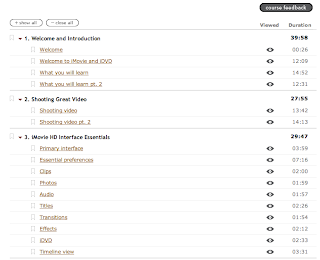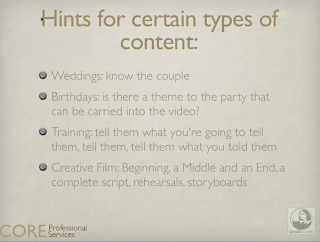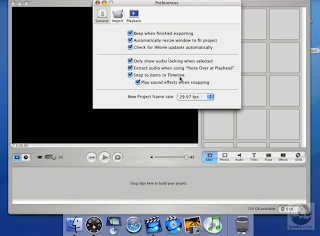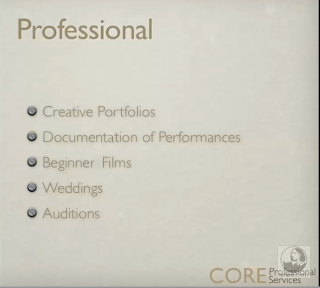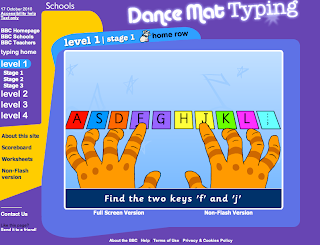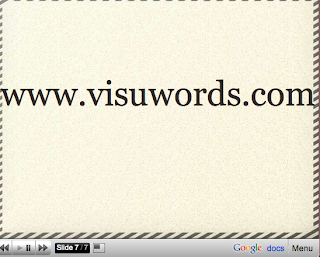Wedding Jamaican Style – I'm trying to tell a story with as few words as possible. The lessons I’ve just finished watching teaches you what you want to do (and not to do) when taking pictures for a wedding. It is now Deborah M. Sanders' Story Time!
The Online Option for teacher's Professional Development (PD) using Web 2.0 Tools of the Trade is fascinating yet daunting! This topic will partially fulfill the requirements for my ETC course at Full Sail University.
Sunday, October 24, 2010
PE 5 iMovie
As I continued with this next lesson I became immersed with information on how to shoot weddings, birthday parties, training videos etc. In addition to the new information, this served as a review on the previous lesson. Part 2 of Shooting Great Video also talked about the quality of your video. This section embodied the “Garbage in/Garbage out” principles. One of the principles I learned in keeping with the concept of “garbage in/garbage out,” is that you must keep subject (“material”) in your frame. Another area discussed was identifying essential pieces of equipment such as the tripod. Tripods are needed for smooth looking videos. There was also info on scene shooting. Shoot more than what you need. Remember, the extra 5 seconds of black space between scenes will help later during editing and formatting. Think of a script or write out a storyboard before you get started. A storyboard, by the way, is a group of pictures (drawings) that provides you with an idea (or ideas) of what your story is about.
I learned about the number of frames (29 frames per sec) for North America. After this, I learned about the clips frame where you can drag and drop any item that is located there. When dragged into the time line, the clips will look identical. The clips can be dragged at the bottom to see how long or short the clip is. There was also more information about photos in this section. Areas such as how to preview reverse, and view time line photos in your iPhoto library were discussed. I then continued with a tour of Titles, Transitions, and Effects.
Please note: The iMovie HD lessons I’ve been watching on the demo screen are somewhat different from what I see on my iMovie screen – the tabs are just in different places. However, I found the training information to still be very helpful. There was advice for enhancements, especially when the trainer advised moviemakers to use restraint when working with effects. After some personal observation, I realized that I am guilty of using too many effects -- I’m learning. Finally, I reached the area of instruction for detailed editing in the time line viewer and rough work in the time line viewer. I was very impressed to see that this section contained a lot of interesting and helpful information. I have not completed my lesson – but I’m on my way.
PE 4 iMovie
I’m really interested in making professional movies. For this reason I choose to review iMovie HD and iMovie DVD.
The beginning of the lesson discussed and demonstrated “how to” steps in order to create professional quality iMovies, iDVDs, and iTunes. For the beginning professional, the lesson discussed creating portfolios, documentation of performances, beginner films, weddings, and auditions. At one time or another, I’ve had to prepare an electronic portfolio to submit with my professional documentation. In most instances, I’ve already taken pictures for many of the suggested or required activities. Therefore, at the beginning of these lessons I spent time watching a PowerPoint tutorial to guide me through the specific tasks I needed to perform. For personal reasons I love to tell stories with pictures. Before being introduced to this technology, I used to take the pictures and then make collages to tell the story. At the very beginning, I realized that this technology replaces telling a story the old way, and I have now evolved into live visual (“video”) motion pictures. See PowerPoint selections below.
FV Option 1 - Change In My Environment
This final video expresses a particular experience myself and other Preschool teachers and students in my district are faced with. This is my attempt to inform others regarding appropriate technological tools for Preschool.
Saturday, October 23, 2010
WK 4 Reading
| Photograph By: Deborah Sanders |
To coin the phrase, “You’ve Come a Long Way Baby”, so has the World Wide Web! Donna Baumbach, (2009), discusses the changes that have evolved within the World Wide Web during this past decade. The WWW has advanced from the simple consumer seeking knowledge, and the code writers of the HTML, to allowing a web participant to enter their own thoughts on a page, in order to collaborate with others around the world. This new expansive, ever-changing, media promotes greater interactivity with other web participants, and even allows participants to create, publish, and share their material. Baumbach, (2009), further examines reasons why School Library Media Specialists should and could use Web 2.0 tools: Some of the most important reasons include: “increasing the libraries budget”, “showcasing activities” within their program for teachers, providing “additional digital tools and resources”, “searching for information” “share information and labor” “do more in less time” and “create a website in seconds” post information, images, video, hyperlinks, and sound”.
To further take a look at the positive uses for Web 2.0 tools in today’s schools, this study gives a comparison of the resources which we are accustomed to: (“Paper, pen, scissors, glue, crayons, construction paper, typewriters or word processors, watercolor…” Baumbach, 2009). Then Baumbach compares these to the web-based resources we have at our fingertips today: (“Computers, social bookmarks, RSS feeds, blogs, wikis, photo editing and photo sharing sites … etc”). An online survey was conducted using 631 Library Media Specialists. This study group was composed, by gathering Elementary, Middle, and High School Library Media Specialists. The questions varied from the knowledge of their use of different tools; to how much time they spent completing various tasks using the tools. One of the noted limitations of this group included lack of knowledge of, and little experience using, many of the tools we use today. In other cases, tools such as blogs could not be accessed. Due to the in-district regulations and state politics that many schools are facing these days, this resulted in a lack of time to research, review and acquire the tools for enhanced training. There are other districts where there has been no training at all. There is a need for professional development to encourage today’s LMS professionals to share their ideas on how to integrate Web 2.0 tools in the classroom, and improve their skills, using the many free tools available.
| Photograph By: Deborah Sanders |
This program examines the usual standard formats for professional in house options for teacher professional development, versus the new leisurely online “anytime” options. Yes, what a mouthful. In other words, teachers in some districts are choosing alternative venues and methods for their PD training. Opting to use the online virtual world as a venue, would eliminate the necessity to employ an increasing number of substitute teachers repeatedly throughout the district. The flexibility of online programs offered within the districts would provide teachers with variable time schedules within which they can complete their PD. Instead of having only one-day, in-house service, they can participate in programs that could last from one week, six weeks or more. The classes can be tailored in conjunction with what the teacher is doing in the classroom, to what the teacher is doing online. As stated by Michelle R. Davis, (2009), “Online professional development, allows access to high-quality instruction and courses that may not be provided locally.” Davis equates this by stating that even with all the documented tracking of information on what teachers are doing and the importance of the experience, “Still, many district-level officials are skeptical on the value of online professional development for their purpose.”
In some cases, it is foreseeable that online PD can eliminate half day or full day recesses for students in order to provide teacher PD. For large school districts, online PD allows reasonable training flexibility in schedules, locations, and times. Various districts are working with universities in their area to provide college credits for their extended courses.
| Photograph By: Deborah Sanders |
Different Spaces: Staff Development for Web 2.0 was a Professional Development exercise conducted by two Australian universities offering new pedagogical technological skills teacher training. Samarawickrema, G., Benson, R., & Brack, C. (2010) noted a study that performed experiments using, “wikis, blogs, social bookmarking, and social networking services, for their learning and teaching value” (Choy & Ng, 2007; Elgort Smith & Toland, 2008). The participants collaborated through group learning. Being a part of this environment provided the participants with more insight and a greater understanding of how their respective students would function in the classroom under similar circumstances. Samarawickrema, et. al. (2010) discusses how learners learn by exchanging and incorporating dialogue between each other. As a result of these initial conclusive findings, the basis of this study was set in motion.
It is interesting to note that the findings of this experiment came as a surprise, particularly since the participants struggled in the Wikis online environment. The participant’s work suggested that instead of using this tool, a face-to-face encounter would have served them better. However, the participants did recognize and understand the dynamic conceptual impact of the tools, thereby directing their focus towards integrating the tools in their future teaching.
| Photograph By: Deborah Sanders |
This review focuses on children between the ages of 3 to 8 and the effects from interactive whiteboards and web sites being incorporated into their classroom. Peggy Lisenbee (2009) discusses her personal use of these tools to create connections for her kindergarten students as they engage in authentic activities. This article provides information on the tools and valuable resources used to impact their learning. As a result of the introduction of these tools, the children were more engaged and were shown to focus more intently on on the task at hand. Interactive technology changes their social interaction by providing a means to communicate with each other. These technologies foster the Constructivist theory into their learning. Lisenbee (2009) noted a study by (DeVries et al. 2001) which stated, “Constructivism highlights children’s own role in learning, how they build their own understanding of experiences, especially when an experience intrigues them. Children refine their thinking through exploration in a social environment.”
Lisenbee (2009) offered suggestions of activities for the whiteboard and web sites that were successful within her classroom environment. One of the most profound and prominent tools she used was the digital whiteboard. The children loved to input their own themes and backgrounds into the task, in order to create and retell their own stories. With regard to websites, Lisenbee (2009) admitted she only used 4 web sites over the course of the school year. She spoke specifically about “. . . streaming videos to enhance learning and help children review and retain information.”
In conclusion, there are myriads of technological experiences available for early childhood students. Exposure and use of these tools has been shown to equip the constructivist self-learner with a clearer understanding of life, learned through their own explorations. For these reasons the need to provide on-going teacher professional development, with these tools integrated into their professional practice, is without a doubt a necessity!
Reference
Baumbach, D. (2009). Web 2.0 and you. Knowledge Quest, 37(4), 12-19. Retrieved from
ERIC database.
Davis, M.R., (2009) Creating value with online teacher training. Teacher Sourcebook, Retrieve
October 16, 2010, from URL. http://www.edweek.org/tsb/articles/
2009/03/16/02onlinepd.h02.htm
Lisenbee, P. (2009). Whiteboards and Web Sites: Digital Tools for the Early Childhood
Curriculum. Young Children, 64(6), 92-95. Retrieved from ERIC database.
Samarawickrema, G., Benson, R., & Brack, C. (2010). Different Spaces: Staff Development
for Web 2.0. Australasian Journal of Educational Technology, 26(1), 44-49.
Retrieved from ERIC database.
Sunday, October 17, 2010
PE3 Google Drawings
Since I have two preschool teachers who will be acting participants in my Action Research I decided to try Google Drawings. Google Drawings used as a Mind Mapping tool will enhance students' comprehension. Simple questions with simple answers. This will be a great visual projection at the computer lab and/or it can be given for a homework assignment to be completed with parent participation. A great opportunity for parents and young children to bond using a fun activity. Students can use the Mind Mapping to express their feelings. This is achieved by viewing virtual animals that live on the farm versus virtual animals that live in the zoo.
Soon our students will visit a pumpkin farm and there they will also encounter a petting zoo as one of the day's adventures. Using Google Drawings as a Mind Map strategy before going to the farm could really send their little minds with gigantic imaginations on an exploration. Look at the sample below.
Soon our students will visit a pumpkin farm and there they will also encounter a petting zoo as one of the day's adventures. Using Google Drawings as a Mind Map strategy before going to the farm could really send their little minds with gigantic imaginations on an exploration. Look at the sample below.
PE 2 Google Presentaion
Google Doc Presentation is a great a tool for teachers to use to give directions to the students for simple projects. The teachers Implement additional web tools within their presentations to make the slides more interesting for the children's enjoyment. I have also taken short stories and created simple directions with to be used with background pictures and captions. This tool can be reformatted for use by both teachers and students. You may publicly view a brief presentation by clicking the following link.
PE 1 Google Survey
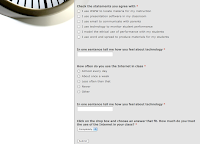
I chose to use Google Docs as an important item to implement within my Action Research Project. It will be very important for me to assess what is going on in the classrooms of the participating instructional teachers with whom I will be working. In order to do this, I will require a variety of communication and feedback in order to learn how the Web 2.0 tools were used in their perspective environments. Below are pictures and this is the working link to my 1st survey.
BP 12 OMM (Tool) eBoard
eBoard will make my Action Research Project move along very smoothly. Please take a look and enjoy!
BP 9 eBoard
 |
| eBoard Home |
While exploring the web for something spectacular to use within my Action Research Project (ARP) I stumbled upon a Web 2.0 cool tool called eBoard. This tool is cool because teachers who are participating throughout my ARP process already have this phenomenal tool within their school district. What I discovered is that either they are not using it at all or, they are not using it to it's fullest potential. Prior to this review I personally had not used this gift. As of today however, this has now changed. Accessibility for students, parents, teachers, administrators and even my professors is available. Users can log in and take a look at items posted on the board. There are many uses for this kind of learning environment. I will personalize one note and make it password protected for my teacher participants and critical friends. This way they will have one location to go to and get updates and information on what I need them to do in order to make my to ARP a smooth piece of work in. Also, for my ARP, teacher participants and critical friends will be able to collaborate with each other using a feature called INote. This is an online discussion that will allow users to post comments that we can be private or shared.
We have a fantastic deal within our districts because eBoard also incorporates many other features such as: Explaining what a note is, how to post a note, add images, and format the text using bold, italicized, centering etc. eBoard shows you how to add pictures and documents, clone (make a copy of a note, and change the order of the notes. To be able to archive information, users can place info in the recycle bin or retrieve info from the recycle bin -- this is another great feature.
What I like most, is that there is no limit on the number of attachments,. Users must be mindful however, that the total size of the attachments combined is limited. Since we all utilize license agreements through our perspective districts, each teacher participant will have up to 500 MB of attachments available. Since these boards will change on a regular basis, I’m confident that positive we will have a plethora of space to work with. This is the easiest and fastest way for educators, parents, and students to post information online. The benefits for teachers to use this tool within their personal environment with their students and parents are only imaginable! Take a look at eBoard.
Deborah
Saturday, October 16, 2010
W3 Reading
 |
| Photograph From: the printshop For MAC |
In a study done by William Bauer Sam Reese, and Peter McAllister (2003), “The purpose was to determine if a one week technology workshop could be an effective means for the professional development of music teachers in using technology for instruction.” The subject of the study was 203 K-12 music teachers from 19 eastern and Midwestern states, all enrolled in a university summer technology workshop. This group consisted of general, vocal/choral, and instrumental music teachers. In summary there were thee gauges of efficiency, “Teacher knowledge, teacher comfort, and frequency of teacher use”.
As this article is not directly referring to children but to adults and their learning of knowledge to teach children a new medium. This speaks to their comfort to teach, and frequency of use to teach with the new technology these teachers could learn. I asked a relatively neophyte, yet extremely qualified music teacher if given the opportunity would she infuse technology into her teaching? Her response was overwhelming exciting. “First, because I do not have a room to call my own it would make it very difficult for me to place students in front of computers I’m not familiar with. Next, the district would have to provide software which children could use to create music.” “However, do you realize how cool that would be if I had my own room and the software? she responded. Se went on to rave about a site called http://www.PianoNanny.com/ it teaches piano on the net and best of all it’s free. Teacher knowledge is there, teacher comfort is there, however, frequency of use is missing from the equations. As students need stimuli, so do teachers. I would say when the external environment is not fed upon there is a loss of the natural stimuili!
Integrating multimedia into the classroom is based on the premise that technology will enhance actual student learning. In addressing this article Donald J. Leu, Jr., questioned the teachers’ complaint of not having enough time to integrate technology within their curriculum framework. Stated clearly, the question becomes: “What will it take to remove stagnation (“old trends”) and allow teachers to obtain professional development so that they can ultimately advance (move forward) and incorporate the use of technology in the classroom?” The nature of reading and writing is rapidly emerging from the traditional usage of textbook, pencil, pen, and paper tools, to using the technological tools embodied by the Internet, digital imaging, graphics, and animation mediums. Donald J. Leu Jr. proposes various strategies for teachers to learn his method of using the Internet to enhance students’ skills and overall levels of achievement. The obvious advantages of using the Internet Workshop program for learning becomes two-fold: it enables the children to teach themselves and provides a vehicle for social interaction with their peers and teachers.
I personally find this subject area significantly essential in creating a foundation for a child’s success in today’s school, and also, for providing a solid foundation for a child as a future employee of society. The learners of today have many requirements including, interactive thirsts and needs, which must be diligently watered and taken care of. Using iPods, interactive whiteboards, blogs, digital stories etc., in the classroom will not only satisfy their thirsts and needs, but will also provide and promote two-fold integration of social camaraderie amongst their peers. Essentially it is time for educators to recognize the need to focus on integrating technology as an instructional tool within the classroom curriculum. As stated above, using the Internet Workshop program for learning provides a two-fold advantage. At the outset, it enables the children to teach themselves and come together socially with peers, and it also enhances the teachers’ ability to integrate technology into their educational practices.
John Allison critiqued the many different views that virtual reality methods/teacher tools had on the profession of teaching history. Some history teachers do not feel that the technology of today will really make a change their “traditional” and “customary” profession of teaching the past. In order to induce this change, history teachers will need to have a tool which will help them provide a more engaging, dynamic, learning environment that will infuse and immerse their students into this technological learning age. The objectivity and the need for the immersion of the past with the reality of the virtual world, has to be defined in such a way that the history teachers themselves would be able to see the realism as it is presented in the technological medium of fact based textbooks and narratives by historians.
Computer generated simulations are only one of the many resources that history teachers can use to teach about artifacts from many moments in time. This study directs us to the web-based path on which students will be able to travel the world via a virtual three-dimensional space. A history teacher, who teaches using virtual reality, can actually reshape the minds of this generation of students by giving them the ability to virtually relive the historical events from the past. One argument this study presents is that history teachers need to make themselves more aware of the designs and development of the virtual element. With all virtual teaching has to offer and the incalculable amount of possibilities this avenue of educational teaching can give to the profession and students, it should be given high priority. This study finalizes it’s thoughts by injecting the need for virtual model environments to be utilized in order to meet the educational needs of the present realities by connecting easily with the past. There is also a need to enhance the socialism aspect of this concept, by bringing the students into the virtual world of learning. History educators should give more thought on how to use these tools now available in the present, for teaching the past on all levels.
Peter R. Albion, (2008) discusses the changes in the WWW in schools and challenges if the Web 1.0 and 2.0 are truly practical for teachers in education. In part Albion, (2008) delivers the information, “Many educators have come to accept the idea of the Internet as a participative medium rather than a mere source of information.” With this stream of thought and willing acceptance, more and more teachers are trying the social media platform and social bookmarking. Because these tools are a part of our everyday lives it has become the responsibility of educators to join in and train the children of today with the tools they are so familiar with!
This study further introduces the fact that Web 2.0 tools are now becoming an integral complement to educating teachers as well as children. Just as we teach children to write about real life experiences, teachers teach through the experiences they have had in the real world. As stated by Albion (2008), “Where teachers have little or no experience of specific practices in the real world, they face particular challenges in designing authentic activities for classroom learning.” In summary, the study explains that while the task of implementing Web 2.0 tools can become a challenge, it has now become a necessary component for the future!
Sunday, October 10, 2010
W2 Reading
We are at it again world!
Creating a personal technology improvement plan for teachers of the gifted
This study by, Kevin Besnoy, discusses the specific obstacles faced by teachers of the Gifted and Talented while trying to integrate technology. “Access and continued professional development,” (Besnoy, 2007) implies that although this is the biggest hindrance, it will also become the eventual process of technology integration.
One way to relieve a teacher’s anxiety is to develop as assessment format to determine where they are and where they need to go. The goal of this format would be to perform was to perform a Personal Technology Improvement Plan, (PTIP). With the development of an attainable long and short-term goal assessment format, the teacher should or will be able to commit to the PTIP. The next step for the teacher would be for the teacher to identify their professional development needs in order to meet their goal. Once this has been accomplished, the teacher must actually seek the PD and utilmitely begin to implement their newly found skill.
Inquiring About Practice: Using web-based materials to develop teacher inquiry
Building an instructional practice that has learning as the essential performance, must afford teachers the opportunity to construct knowledge, information, abilities and dispositions that support their learning efforts (Richert, A.E., 2005). Richert discusses pedagogical decisions based on teacher learning and the reform approaches that have appeared recently. Richert suggests that the best learning is from one’s own practice and from that of other’s practices. This thought was applied by two of Richert’s students. They built web sites that gave evidence to the process of their inquiry and proof of the analysis of their work. The thought behind this inquiry stance was so that her students would one day take the initiative to continue with the process on their own.
Whiteboards and Web Sites: Digital Tools for the Early Childhood Curriculum
Peggy Lisenbee incorporates powerful digital tools for her early learners. The traditional methods are out the door and new innovative skills for teaching the young have become the standard in her classes. Lisenbee noticed that children were more engaged and jumped at the opportunity to participate in lessons when technology was incorporated. If a child, is interested the likely hood of knowledge gained in this environment is inevitable. Using a digital whiteboard in the early childhood setting, enables children to use their fingers as a pen to construct new learning.
This study also discusses technology and the constructivist approach to learning. Simply stated: Children will play an important role in their own learning. With the implementation of interactive whiteboards and stimulating animated multimedia, the prescription for learning has been rewritten. The main focus is for young people to be able to, “Explore, discover, and construct their own understandings through the use of technology” (Lisenbee, 2009).
Can Technology Narrow the Black-White Achievement Gap?
The purpose of this study was to determine if technology could close the gap in test scores of the African American students when compared with their white counterparts in the state of Missouri. This project was a joint effort between the University of Missouri and the Elementary and Secondary Department of Education in Missouri. The teachers were structured in a two-year professional development study, which included coaching during class sessions. State assessments were conducted at 39 schools of African American students enrolled in these classes named, “eMINTS-enhancing Missouri’s Instructional Networked Teaching Strategies” (Beglau 2005). Their achievements were compared to white students who did not participate in the eMINTS training. The results were clear: The multimedia tools used in the eMINTS classrooms proved positive and those students’ [African Americans] scores conclusively closed the gap of the students not participating in the eMINTS program.
Practice, reflection, feedback, and redesign serve as critical components of this learning approach. I’m an advocate for learning new strategies to teach. If given the opportunity, I would invite the idea of training and testing the students from the district within which I work, to compete with students from other surrounding suburban districts. A person, a teacher, or a student may have preferences for learning something new and a completely different preference when it comes to refreshing knowledge and skills that simply need updating. If technology could create a balance in the learning grid between two totally different measurable outcomes of learning that would have a positive effect on the profession of education.
References
Beglau, M. (2005). Can technology narrow the black-white achievement gap? T.H.E. Journal, 32(12), 13-17. Retrieved October 7, 2010.
Besony, K. (2007). Creating a personal technology improvement plan for teachers of the gifted. Gifted Child Today, 30(04), 45-49. Retrieved October 9, 2010.
Lisenbee, P. (2009). Whiteboards and web sites: Digital tools for the early childhood curriculum. Young Child, 16(04), 92-95. Retrieved October 9, 2010.
Richert, A.E. (2005). Inquiring about practice: Using web-based materials to develop teacher inquiry. Teaching Education, 16(04), 297-310. Retrieved October 9, 2010.
Saturday, October 9, 2010
BP7 Comment on Sue Parlin's Blog
| Add caption |
I'm interested in the following blog post because I too have experienced taking 3rd grade students on a similar journey. For more information please follow my comments on Sue Parlin's Blog.
BP6 Comment on Heather Anderson Blog
| Photograph by: Deborah Sanders |
I really enjoyed reading a delightful blog written by Heather Anderson on: DoInk, Creating Animations. My vision for using this tool in the classroom is unlimited. Please, follow this link to my comments on Heather Anderson’s blog. Join me and learn more about DoInk!
BP5 Pop Feedback
| Photograph by: Deborah Sanders |
It is a brand new day world and I’m here to talk about Pop Feedback a limited free survey that incorporates a plug-in application so you can insert a form directly into to your web page or blog. My Action Research will require surveys, interviews, and observations from teachers. This tool will help me gain quick feedback from my participants who are located in various places. It will be easier to stay in contact with my subjects using Pop Feedback. All they will need to do is visit my AR site to learn about the new surveys. This tool will eradicate one of my contact dilemmas. This is definitely one of the Web 2.0 tools I plan on instituting
Pop Feedack is a Web-based online survey solution. I’ll be able to add and remove questions easily right from the dashboard. There are controls to adjust how long you want the survey to appear and or how many times it will appear according to the times the page is viewed. I would make this setting for each time the page is viewed. It is also easy to specify the page I want the pop survey to appear on. Quick questions for necessary responses from my survey subjects are critical for data purposes. The subjects will be able to respond to specified ongoing question each time they visit my blog, or AR website. Pop Feedback provides easy access with questions located on the bottom right hand corner of the page. Just like my critical friends my survey subjects will need to visit weekly. The survey subject’s input is the meat of this technological cost effective adventure.
Cost effectiveness presents the only downside of this tool. In order to export the responses to Microsoft Excel* one must pay a fee of $39.00 a month. This is absolutely out of the question. However, I’ve been grading papers for years and one tiny survey once a week can be transformed into a data spreadsheet for graphs very easily.
Another feature I’m highly interested in is a POLL CODE. Best of all Poll Code is free of charge and it can also be added to web sites and blogs also. Variety is the spice of life! My subject teachers will be able to implement a short poll when student assignments have been completed. Keep perusing for further updates and new technologic tools for My AR. In the meantime lets take a look at Pop Feedback!
Monday, October 4, 2010
BP 4 StoryJumper
StoryJumper sets the imagination of Kids from “1 – 92”, on a virtual writing adventure. Children of all ages can tell their story in just 7 simple steps, or they can relax and read one of the many adventures already set in place. One of the key components that I like is the child can use the artwork that is provided for the back drop of their book, or they can use their own personal pictures or drawings. The most fantastic part of this story is the art of sharing. Yes, immediately you can share your book online or purchase a hard cover for your personal library.
Three more important components of storyjumper are Teachers, Parents, and You the author. What a wonderful way to promote writing and literacy! Let’s take a look and see how StoryJumper works.
Make story jumper part of your virtual library.
Sunday, October 3, 2010
W1 Reading
Recently my Action Research changed from focusing on math while implementing Web 2.0 tools in the preschool classroom. Now, my concentration will be redirected to the use of Web 2.0 tools as online instruments for teacher Professional Development. As a result of this study, I hope to be able to determine whether there is a measured increase in learning levels among teaching professionals.
I’ve been pleased with the amount of recent research I’ve been able to find. The following article, “Learning With Blogs and Wikis” is right on target with my Action Research. Bill Ferriter discusses how, “Technology has made it easier for educators to embrace continual professional development”. In the past, most teacher-oriented professional development consisted of a room full of teachers listening to a lecture and observing a presentation. After the presentation, the teachers were left to their own reflections to determine how to use what they had learned to improve their instruction technique(s). As stated by Ferreter, “Changing Times, Changing Tools,” I agree that it is time to incorporate technology in the professional development of the individuals who will be doing the teaching. How can educators prepare our children to interact in today’s technological environment if they are not equipped with the knowledge and familiar with the tools themselves? Some of these tools include learning about: Blogging, incorporating Reader and Wikis. With these tools, educators now have the opportunity to have input, a voice, a word, “say so”, and a decisive platform to change the world in which we work and, most importantly, teach!
While reading “Technology as a Tool: Applying an Instructional Model to Teach Middle School Students to Use Technology as a Mediator of Learning” I was able to identify with some of the struggles teachers were having with applying the technological instruction. The teachers found it frustrating to teach the new technologies in addition to teaching understanding of a new concept. I found that some of the main factors, which attribute to the frustration, are the lack of time spent on the introduction of the tools and also, the ineffective use of the tools. Instead of using the tools and treating them as a “new experience”, they were simply being used as a shortcut to promote higher learning.
| Photograph by: Deborah Sanders |
“Revamping Professional Development for Technology Integration and Fluency” This composition defines technology in its broadest form and calls for the utilization of all available technological trinkets for integration into the classroom. Sandra Kay Plair discusses the responsibility of integrating technology from the view of the, “No Child Left Behind Act.” Today’s teachers are over stressed, work under tremendous pressure and move with difficulty into this new technology-based environment. This is a direct result of the change in teacher duties: what was once the “computer” teacher’s job is now the responsibility of all teachers. Another problem is changing the limited thinking and knowledge of veteran teachers to a higher level of using technology beyond simple word processing. The progress of the introduction of technology in professional development is going to proceed at a “snail’s pace” and will require constant on-going support.
Finally, “When Teachers Drive Their Learning” is a breath of fresh air for educators across the nation. Now, teachers get to decide what they want to teach and their training is conducted, “during contract hours.” This program is called Fusion and the plan is for all teachers to be offered courses designed to improve their specific skill and/or craft. The ultimate motivators are the strategies and procedures available for teachers to become experts and also, giving teachers a choice in their desired course of learning. Time was a critical factor in the developmental phase of this training program and several initial avenues used to integrate time, ultimately failed. That’s when, after further study and experimental stages, “The Need for Differentiated PD” was finally launched and put into operation.
I am extremely excited about this new AR project I’m beginning to work on. Keep viewing my submissions and I hope to keep your interest as well as excite you too.
Carter, G., Griffin,A. Reid., (2004). Technology as a tool: Applying an instructional model to teach middles students to use technology as a mediator of learning. Journal of Science Education and Technology, Vol. 13, No. 4, Retrieved October 2, 2010
Ferriter, B. 2009. Learning with Blogs and Wikis. Educational Leadership, Retrieved October 2, 2010
Plair, K. S., (2008). Revamping professional development for technology integration and fluency. Clearing House. Retrieved October 2, 2010
Semadeni, J. 2010. When Teachers Drive Their Learning, 4. http://www.ascd.org/publications/educational-leadership/may10/vol67/num08/When-Teachers-Drive-Their-Learning.aspx. Retrieved October 2, 2010,
Saturday, October 2, 2010
BP2_iGoogle Screen Shots
Thursday, September 30, 2010
BP1_Google Reader
| Photograph By: Deborah Sanders |
The current state of education in today’s society has placed upon teachers a demanding responsibility. An even greater emphasis is now focused on the implementation of new methods to teach our children utilizing the best tools and methodology available. Overall, teachers are so busy with the day-to-day challenges; we typically perform our teaching roles in the same manner in which we were taught. The purpose of this blog is to address some of the many different levels of technological material, which can be used to facilitate teaching and learning. Web 2.0 Tools of the Trade for teachers will be my focus for my 2010-2011 Action Research. These tools for educators fulfill teacher training (PD) and student learning requirements. The blogs I chose to follow will benefit and assist educators to fulfill their fundamental job of integrating technology into their teaching.
This online magazine blog is packed with an arsenal of technological tools for neophytes and/or seasoned educators who are interested in accumulating a vast resource of cutting edge technology information.
This blog houses a plethora of many smaller blogs that touch on topics such as: data driven accountability, administrators, assessments, video education, and the list goes on. For the visual eye, there are interesting, eye-catching quotes regarding the future of teaching and education. In addition, there are short videos that spark the educational thought process. I like this blog especially because it contains skills, problems, solutions, activities, and plain, old-fashioned “good reading” regarding today’s educational landscape.
Do you want to talk about integrating technology into the classroom? In that case, you should go to the iLearn Technology Blog. The attraction for me was the lesson plan and templates for a “Lesson on Empathy.” There is a template that can be purchased for $ .99 cents – it is well worth the investment.
While following one of my Full Sail University classmates I stumbled upon this site. Because of the increased activity of spammers, a person has to be approved for membership. I was approved as a member as of September 30th, 2010. To me CLASSROOM 2.0 is more like a support group for fellow teachers or anyone interested in acquiring knowledge about Web 2.0 technology. What I found most interesting about this blog is that it connects you to Interview Recordings, and free live workshops. There are special interest groups as well as funny and interesting cartoons. Stop being a follower, become a member today.
The AASL has taken accountability to a higher level. This blog introduces educators to a wide variety of teaching and learning resources. This is virtually a “one-stop” shop for education. This blog provides assistance in locating strategies, grants, and grassroots groups in the fields of digital storytelling, managing and organizing, curriculum sharing and social networking, to name a few. I would highly recommend utilization of this blog for all educators to assist in their professional learning development.
Subscribe to:
Posts (Atom)
